Description
Neofloxacin–P 10%
Composition: 1 g oral powder:
Enrofloxacin 100 mg
Indications: Pigs: Treatment of diseases caused by strains of bacteria and
mycoplasmas, which are sensitive to enrofloxacin – respiratory system (mycoplasmosis,
pasteurellosis); the gastrointestinal system (colibacillosis) and MMA syndrome and
mixed infections (eg. Enzootic pneumonia)
Calves: treatment of diseases of the respiratory and gastrointestinal system caused by
bacteria and mycoplasmas sensitive to enrofloxacin (patereloza, bacterial pneumonia,
mycoplasmosis, colibacillosis), where clinical experience and, whenever possible,
sensitivity test confirms that enrofloxacin is the drug of choice.
Poultry: Treatment of diseases of the respiratory and digestive systems of poultry caused
by strains of the following bacteria susceptible to enrofloxacin: Mycoplasma
gallisepticum, Mycoplasma synoviae, Avibacterium paragallinarum, Pasteurella
multocida and Escherichia coli.
Contraindications: It is not given in the case of known hypersensitivity to the active
substance.
Not given to laying hens.
Do not use for prophylactic purposes.
Do not use in clusters / groups of pigs at the earlier recorded appearance of resistance /
cross resistance to (fluoro) quinolones.
Side effects: After the drug administration gastrointestinal symptoms may occur
(vomiting, diarrhea), skin rashes and hyper-arousal CNS. Photosensitive reaction is also
possible if the treated animals are exposed to sunlight.
Target species: pigs, calves, poultry (broilers and turkeys).
Dosage and method of administration:
The use of the addition of the feed.
The use by the addition in the drinking water / milk.
Application:
Pigs: The recommended dose of enrofloxacin is 2.5-5 mg / kg bw daily for 3-5 days.
The drug is used in prepared foods in accordance with the daily food intake.
(Example: If the food intake per kg bw per day 45-50 grams of the drug per 1 ton of
finished food products is 0.5 kg (dose 2.5 mg enrofloxacin / kg bw) and 1 kg of the drug
(dose 5 mg enrofloxacin / kg bw) )
Calves: The recommended dose of enrofloxacin is 2.5 mg / kg bw (2.5 g of drug / 100 kg
PP values) for 3 days. When salmonellosis and respiratory infections with complications
is recommended to use a dose of 5 mg / kg bw / day (5 g drug / 100 kg bw) for 5 days.
The drug should be mixed with milk or milk replacer with water immediately prior to
administration. Administered via supply bottle.
Poultry: The recommended dose of enrofloxacin is 10 mg / kg bw per day. It is used by
admixing of 1 ton of finished feed or 10g / 10 kg of finished food products. Therapy
administered 3-5 days; 5 days in the case of mixed infection and chronic course of the
disease. If within 2-3 days there is no clinical improvement is necessary to consider the
use of other therapies, in accordance with the results of susceptibility testing agents.
When mass therapy, it is recommended that the drug is first mixed with a small amount
of food, and then the rest in order to be uniformly applied to the total amount of food.
Instructions for proper use of the drug:
The use of this drug must be based on clinical findings, and if possible, the results of
susceptibility testing. The use of this drug should be limited to cases where the agent is
exhibited resistance to other antibiotics; and when bacteriological confirmation of
diagnosis and susceptibility testing of pathogens to justify its use.
The drug must be administered in dosages and in the manner prescribed, or otherwise
may occur pathogen resistance to flouorohinolone and reduce efficiency in therapy other
quinolones due to potential cross-resistance.
Wrong is the use of fluorinated quinolones, in the so-called. preventive therapy in day-
old chicks in immigration. This not only encourages faster development of resistant
microorganisms, but also increases the dose of fluoroquinolones that later proves to be
an effective therapy.
The drug involved in the food should be used immediately.
Withdrawal period: Meat of treated pigs not for human consumption during treatment
after the last application of the medicine 8 days for calfs, 10 days for pigs, 7 days for
chickens and 13 days for turkey.
Special considerations:
For use in animals:
Fluoroquinolones should only be used for the treatment of diseases for which there are
already aware or are expected to respond poorly to other classes of antimicrobial drugs.
Whenever possible, fluoroquinolones should only be based on the findings of
susceptibility testing.
The drug, which is not in accordance with the instructions given in the summary of
product characteristics and the leaflet could lead to an increase in the representation of
bacteria resistant to fluoroquinolones and reduce the effectiveness of treatment with
other quinolones, due to possible cross-resistance.
Since enrofloxacin was first registered for use in poultry, reducing the sensitivity of E. coli
to fluoroquinolones is widespread, as well as the emergence of reszistentnih
microorganisms. The emergence of resistance was recorded with Mycoplasma synoviae
in EU countries.
Use during pregnancy and lactation:
Not recommended for use during pregnancy.
The drug is not used for laying hens, nor for at least 14 days prior to dissemination.
Special precautions for the person administering veterinary medicinal product to
animals:
When mixing the drug, avoid direct contact with the skin and mucous membranes due to
potential sensitization, contact dermatitis or developing hypersensitivity reactions.
Those preparing medicated feed should adhere to the basic measures of protection:
wear protective gloves and a face mask, protective clothing, and do not eat, do not drink
and do not smoke while handling the drug.
After handling the drug should wash your hands.
People sensitive to fluoroquinolones should avoid contact with the drug.
In case of allergic reactions or other adverse reactions in people who give animals
medicine, it is necessary to see a physician immediately and show him the packaging of
the drug or a drug user.
Special precautions for disposal and destruction of drug:
Unused drug or drug residues shall be destroyed in accordance with applicable
regulations.
Storage: Store in a cool, dark place, at temperatures up to 25˚C. Keep out of the reach
of children.
Method of issuance: On prescription of veterinarian.
Shelf life: 2 years in original packaging.
Shelf life after opening: use immediately
Shelf-life after mixing with water, milk or milk replacer: use immediately
ATCvet code: QJ01MA90
Packaging: bags of 100 g, 500 g and 5 kg
Number and date of registration:
1x 100g 323-01-00523-14-001 date 17.04.2015.
1x 500g 323-01-00524-14-001 date 17.04.2015.
1x 5kg 323-01-00525-14-001 date 17.04.2015.
Producer: “FM Pharm”, Subotica, 024/548-130
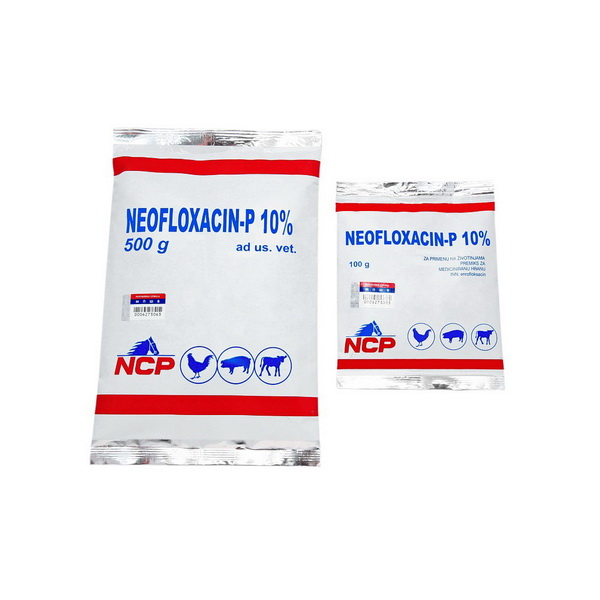
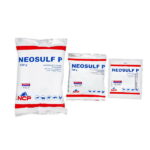
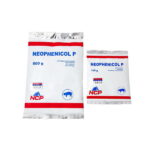
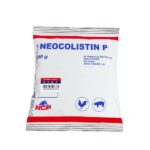
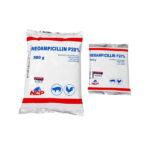
Reviews
There are no reviews yet.